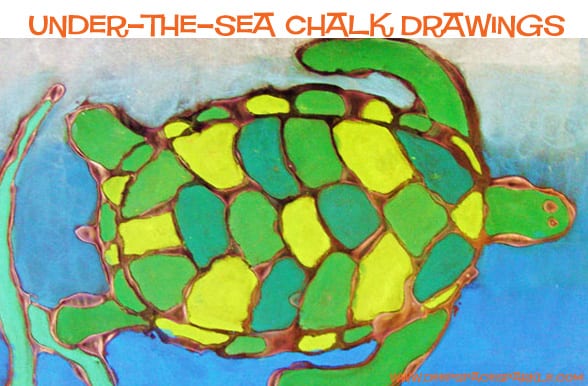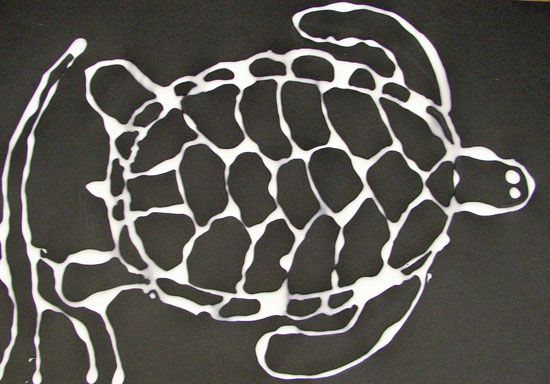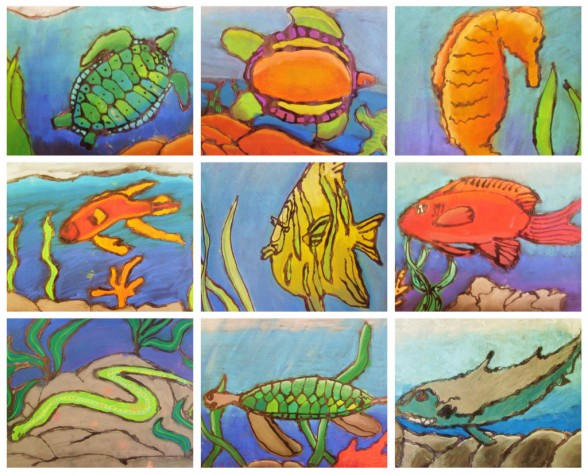I discovered this lesson while browsing through the Artsonia site recently. Gulf Elementary in Cape Coral, Florida displayed this beautiful Under-the-Sea chalk art on their school page. Although no lesson plans accompanied the piece, I experimented and came up with my own.
I used this lesson for fourth grade students, but could be used for a fifth and sixth as well. For younger grades, use an easier subject matter (maybe penguins or sunflowers) and the results will be equally as grand.
Sea Creatures
I passed out sample drawings of various sea life…dolphins, sharks, sea turtles, seahorses, fish, etc. Coloring books that you find at craft stores are especially helpful drawing aids. I demonstrate the basic principals in drawing the fish (I use the “shape” philosophy) and try to cover at least three different types (oval fish, elongated dolphins and round turtles). I encourage the kids to draw big, actually, I insist they draw big as they can because the glue will be applied next…
Drawing with Glue
Each student receives one piece of 12″ x 18″ black construction paper, a pencil, eraser and a bottle of white school glue.
I demonstrate the technique for the tracing pencil lines with the glue. Basically, I tell them to use the glue bottle as they would a pencil. The orange tip is like the lead: touch the paper, don’t hover above it and squeeze carefully.
After drawing the fish, sea turtle, etc (only one please!), trace the pencil lines with the glue. Lay papers flat on the floor until dry.
Tip: If you have a drying rack that has a slight tilt, it’s wise to lay the pieces on the floor until the glue “sets”, then you can rack ’em up.
Tip #2: Be careful the kids (or any wayward parent helper) don’t track footprints over the art. Yes, this happened to me.
Chalk Pastel
Once the white school glue dries, you will notice that the glue dries clear. This reveals the black paper underneath, making the glue appear to be black. Cool, huh? Using chalk pastel, the kids color in their fish, seaweed and the ocean. Apply the chalk right up close to the glue “wall”. This wall prevents the pastel from leeching onto the other colors. The top of their picture should be a light colored ocean color and the bottom should be darker. Gradations of blue and streaks of white are used to achieve this gradation and the sun’s filtration.
Adding Contrast
I demonstrate how to add highlights with white chalk and tones with black chalk. I give them the “black pastel is powerful so control it” speech and let the kids experiment with the highlighting.
Adding Details
The children now add details such as scales, patterns, lines, gills to their pictures using chalk and without blending their lines in.
Want a free drawing guide? Click the image below and we’ll send you our Sea Turtle and Fish Drawing Guide PDF!















This is a beautiful project. I do a very similar one using oil pastels and glue outline. I also introduce the work of Georges Rouault with his bold black lines that help unify the picture. I am going to try it with the chalks for a new twist. Thanks!
Jane
K-5 Art
Fayetteville, AR
I love your site. We have very similar taste in subject matter and projects for kids. I have used chalk and glue for Franz Marc inspired artwork and gotten beautiful results. Also for Georgia O'Keefe inspired work. The one thing about chalk…how to keep it from coming off all over everything…the walls, for example, your clothes when you put them up and take them down. I have tried spraying them with fix, but with 60 kids, I nearly asphyxiate. Sometimes the fixative changes the colors a bit, especially if you use chalk on black paper. You can also get nice results with clear glue on black paper with chalk. I long for an easy/non toxic way to fix the chalk..alas, I have no answers to that one. Can't beat the color, though.
I laminate colored chalk drawings. They look great and no mess!
I also laminate special chalk pieces throughout the year! Love this project.
Aquanet hairspray, or any aerosol type hairspray works great for fixing chalk pastel. Plus, it smells much better than the traditional fixatives.
Yes! Aquanet rules!
I forgot to mention, I teach art at St. Johns Lower School in Houston. We have art on our site too. Here's the tiny URL for the Lower School Art page: http://tiny.cc/1RbJp
There is a media gallery over on the right hand side near the bottom with a lot of our work in it. I think you will agree we have similar taste! I got some nice ideas from your site tonight.
Linda
Hi Linda,
I'm familiar with your site. I use to peruse it when I first began teaching.
It's nice that you found me as now I get the chance to say "thank you!" for all your wonderful ideas!
I LOVE the collage cities. I noticed that are a shared project. What are the basic steps for making this project and how time intensive is it?
Thanks for visiting.
Moonbird – spray hairspray (like Aquanet) for an alternative to Spray fixative, less fumes!
I've done this with Kinder's at Halloween, I did the glue as spiderwebs, they added chalk and blended. They loved getting so messy!
Gel glue is even better fo getting beautiful lines that reflect the color of the paper that you use and really add to the art. The kids think its magical.
I do not understand the purpose of using glue to make an outline? Do you peel off the glue to reveal the black paper at some point?
Hi Davis,
In art projects, I often aim to have a subject stand out and be the focal point. When using chalk pastels, it can sometimes be hard to keep the colors from blending together thus obscuring the details of the art. Glue is a great way to distinguish these lines. Oil pastel is another. What happens is the white glue dries clear on black paper, revealing a thick black line.
It also serves as a barrier when blending colors. Push the chalk pastel right up to the glue.
Try it and you’ll see what all the fuss is about!
Thank you so much! That was great… and fast!
hi, great site.
i want to do this project with 3rd and 4th graders but i’m worried it will become an expensive project. what brand chalks do you use?
thanks, sharon
Hi Sharon,
I have a group of 20 grade 3 students. I often have the kids work in groups to share the pastels, that way I don’t need so many boxes. I really don’t know what brand I have (the school ordered them), but in my experience with kids, pretty much any brand will do – you don’t need artist quality!
Also, as long as you warn the kids to be careful not to break the pastels (they are so fragile), they will last longer than you might think 🙂
I actually break the pastels in my intro- more sharp corners!
I love the idea of this project and have just bought some chalk pastels to use with a large group of mixed age children at Art Club. However I don’t have enough glue bottles to go round – I wonder if it would work ok if we just painted the glue on using fairly fine brushes? Hopefully so, will give it a try later!
I’m not sure about that. The reason why it works is that the glue bottles dispenses a thick barrier. This allows the children to push the chalk up close to the wall of dried glue. My suggestion is to try one yourself and see if it works. I always try things before introducing the idea to students. You really learn the tricks and tips that way. Good luck and let me know how it turns out!
Hi Patty,
I have seen a similar project using black glue on white paper for the outline and then using tempera biggie cakes to paint instead of chalk. I am wanting to do this with flowers on big 18×24 white paper. Do you know how to dye the glue black? I thought it was India Ink, but when I tried mixing it with Elmer’s school glue it turned thick and stringy. Am I using the wrong kind of glue? Have you heard of this before?
Thanks,
Jennifer
Hi Jennifer. I’ve always used Elmer’s school glue with regular black tempera paint. If it is too thick, water it down. As for the stringy…hmmm.Sometimes the chemical reaction of some types of paint cause glue to turn stringy but that’s never happened to me. Let me know how it works. I love experiments!
Love the art projects with glue however I had two problems that perhaps u can help with. I used clear glue and got so many bubbles and using a pin to pop the bubbles did not work. Also I used chalk pastels and was surprised to find that some students were (unintentionally) able to apply color right over the dried glue. H0w to avoid these issues? Thanks for your advice! Annette
I’ve never used clear glue before so I can only offer my thoughts on what happens when you use white school glue. Going forward, the one piece I have is to always try the project first…maybe not the entire thing, but just a portion to see how your art supplies and directions work. This is especially true if you are using a product I didn’t use. Also, try not to worry about air bubbles or kids coloring over the chalk. Tell the kids what you expected might happen, then talk about what did happen and then see what everyone thinks about it. Still,next time use white glue! Hope this helps.
i love art is good for me it fun
Hi Patty, I am a very new art docent and have so much to learn. Your website has been so helpful. I’d like to try this lesson. What do you mean by the “shape” philosophy in drawing the fish? Also do you have a video that demonstrates how to highlight with the black and white pastel? Thank you so much!!!
If you are brand new to art, you may want to check out my Art School for Kids video program. It was designed for art docents. Here’s a link: https://www.deepspacesparkle.com/asfk/
визы в китай екатеринбург мультивиза
Always great to share w/ my kids!
Many thanks!
Looks like fun.
I get a 404 message when I try to download the drawing guide. Glerp! :\
Is there anywhere else that I can find it? Thank you! Looks neat!
Hi Dwyerm! This is Bethany from Team Sparkle. Thanks so much for letting us know that there is an issue with the link. We working on getting that taken care of, so please try again shortly. Thanks!
how do you spread the chalk color even like in the water.blue ,chalk has a edge line?
Chalk and glue projects are always a hit!